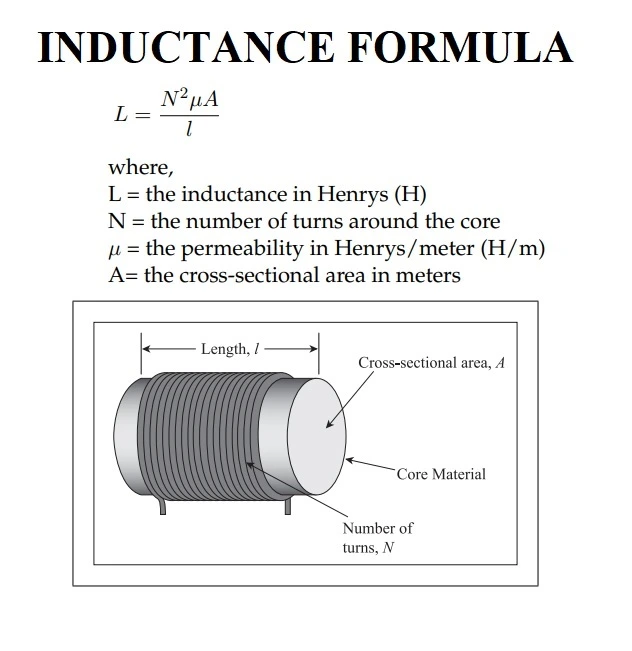
What is an Inductor in Electronics?
Inductors are two terminal, passive energy storage devices. They store electrical potential energy in the form of an magnetic field around the current carrying conductor forming the inductor. Let’s see the Working of an Inductor in detail.
Inductance:
- A current generated in a conductor by a changing magnetic field is proportional to the rate of change of the magnetic field. This effect is called INDUCTANCE and is given the symbol L. It is measured in units called the henry (H) named after the American Physicist Joseph Henry (1797-1878)

Construction of Inductor
- Inductors are components that are simple in their construction, consisting of coils of insulated copper wire wound around a former that will have some type of core at its centre.
- This core might be a metal such as iron that can be easily magnetised; or in high frequency inductors, it will more likely to be just air.
Working of an Inductor
- Another name used for an inductor is a “Choke”. Inductors, being just coils of copper wire, will allow DC to pass easily, but when AC is applied, inductors create an opposition to current flow that increases, as the frequency of the alternating current increases. Therefore, AC is prevented from flowing or is “Choked off” while DC is allowed to pass. This effect is used in power supply circuits where the public AC mains (line) supply has to be converted to a DC supply suitable for powering electronic circuits.
- Inductors depend for their action on the magnetic field that is present around any conductor when it is carrying a current. If the wire coil is wound around a core made of a material that is easily magnetised, such as iron, then the magnetic field around the coil is concentrated within the core; this greatly increases the efficiency of the inductor.
Working Principle of Inductor:
- When a DC voltage is connected across an inductor, a current is made to flow through the inductor. As this current increases at switch on, an increasing magnetic field is created around the coils of wire.
- The electrical energy used in creating the magnetic field is therefore being stored as magnetic energy. Also when the energy in a magnetic field is changing, this will induce a voltage into those same coils that are setting up the magnetic field.
- However the induced voltage, called an ‘electromagnetic force of self induction’ will be in the opposite polarity to the applied voltage that is setting up the magnetic field; therefore this induced e.m.f. is also commonly called a ‘back e.m.f.’ and its effect is to slow down the otherwise rapid change of current that takes place at switch on.
- As the current through the inductor builds up, the rate of change of current has reduced, due to the back emf, and so has the back emf due to the reduced rate of change of the current. The electrical energy applied to the inductor has now been converted into magnetic energy and also is stored in the magnetic field set up around the inductor.
Application of an Inductor
Inductors are extensively used in alternating current (AC) applications such as radio, TV and also communications equipment.
LIKE WHAT YOU’RE READING?
CHECK OUT SOME OF OUR OTHER GREAT CONTENT HERE:
- LVDT- CONSTRUCTION, WORKING PRINCIPLE , APPLICATIONS, ADVANTAGES, AND DISADVANTAGES
- HOW AN IGBT WORKS?
- SCR VI CHARACTERISTICS EXPLAINED IN DETAIL
- STEP UP TRANSFORMER: DEFINITION, CONSTRUCTION, WORKING & APPLICATIONS
- LIMITATIONS OF OHM’S LAW
- INDUCTION MOTOR: WORKING PRINCIPLE, TYPES & APPLICATION
- STRAIN GAUGE WORKING PRINCIPLE
- WHAT IS OPERATING SYSTEM AND ITS TYPE
- WHAT ARE THE USES OF CAPACITOR
- HOW THE MOSFET WORKS?
- POWER FACTOR IMPROVEMENT METHODS
- WORKING PRINCIPLE OF SYNCHRONOUS MOTOR
- SYNCHRONOUS MOTOR STARTING METHOD
- WHY THE SYNCHRONOUS MOTOR IS NOT SELF STARTING
- WHAT IS A UNIVERSAL MOTOR ?
- WHAT IS THE ZENER DIODE? – EXPLAINED




8 Comments